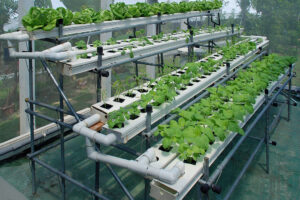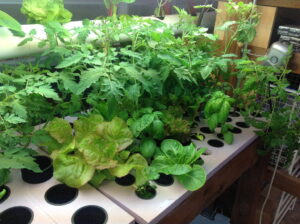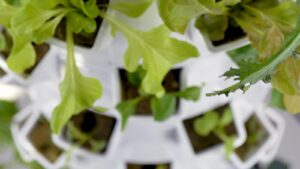In the mysterious world of horticulture, where soil is replaced by nutrient solutions, plants grow with an almost magical speed and vitality. However, behind this seemingly enchanted environment lies a delicate balance that can be easily disrupted. Like the intricate dance of a botanical symphony, the nutrient solution within hydroponic systems must harmonize perfectly in order to fuel healthy plant growth. But what happens when this balance falters? Enter the realm of troubleshooting nutrient solution imbalances, where we embark on a quest to unravel the enigma behind maintaining thriving plant life. Join us as we explore the solutions that will keep your green companions flourishing, bringing the garden of your dreams to life. Welcome to a world where science and art intertwine, where equilibrium reigns supreme, and where nature’s creations bask in a spectrum of vibrant hues.
Common Nutrient Solution Imbalances: Identifying Deficiencies and Excesses
Nutrient solution imbalances can present challenges to the optimal growth of plants. Identifying and addressing these imbalances is crucial in maintaining healthy plant development. In this post, we will dive into some common nutrient solution imbalances, exploring both deficiencies and excesses, and provide effective solutions to promote robust plant growth.
Identifying Deficiencies
Nutrient deficiencies can manifest in various ways, affecting different parts of the plant. Keep an eye out for these signs to detect potential nutrient deficiencies:
- Yellowing or chlorosis of leaves
- Stunted growth or irregular plant shape
- Leaf curling or distortion
- Premature leaf drop
Addressing Deficiencies
Once a deficiency is identified, it is crucial to take prompt action. Solutions for nutrient deficiencies include:
- Adjusting pH levels to promote nutrient availability
- Adding fertilizer rich in the deficient nutrient
- Varying nutrient ratios in the solution to meet plant-specific requirements
- Ensuring adequate watering and drainage to prevent nutrient runoff or buildup
Dealing with Excesses
While nutrient deficiencies can hinder plant growth, excess nutrients can be equally detrimental. Signs of nutrient excess include:
- Burnt or discolored leaf tips and edges
- Wilting or limp stems
- Reduced flowering or fruiting
- Inhibited root development
To restore balance and promote healthy growth, consider these potential solutions for tackling nutrient excesses:
- Flush the growing medium with pH-balanced water to leach out excess nutrients
- Gradually reduce the concentration of nutrient solution
- Improve aeration to prevent nutrient accumulation in stagnant water
- Regularly monitor and adjust nutrient solution strength according to plant needs
Understanding the Impact of Nutrient Imbalances on Plant Health
Are your plants not growing as healthy as they should? Do you notice yellowing leaves or stunted growth? It’s time to consider the impact of nutrient imbalances on your plant’s health. Nutrient solution imbalances can greatly affect the overall well-being of your plants, hindering their ability to thrive and limiting their potential.
One common nutrient imbalance is the lack of nitrogen. Nitrogen plays a crucial role in promoting leafy green growth and is essential for the formation of chlorophyll. Without enough nitrogen, your plants may exhibit pale or yellow leaves, along with slow growth. To address this imbalance, consider adding nitrogen-rich fertilizers or organic matter, such as compost, to your soil.
Another nutrient imbalance to watch out for is excessive phosphorus. While phosphorus is vital for root development and overall plant health, too much of it can cause problems. Overloading your plants with phosphorus can result in nutrient lockout, preventing them from accessing other essential elements. To mitigate this issue, ensure that the ratio of phosphorus to other nutrients in your nutrient solution is balanced. Regularly testing and adjusting your nutrient solution’s pH levels can also help prevent phosphorus accumulation.
Practical Tips and Techniques for pH Regulation in Hydroponics
In hydroponics, maintaining the right pH level is crucial for healthy plant growth. However, nutrient solution imbalances can sometimes throw off the pH, leading to plant stress and reduced yields. If you’re experiencing such issues, worry not! We have compiled a set of practical tips and techniques to help you troubleshoot and find solutions for maintaining a consistently balanced pH in your hydroponic system.
Firstly, regularly monitoring and adjusting your nutrient solution’s pH is essential. Invest in a reliable pH meter and kit to ensure accurate readings. Start by measuring the pH of your solution at least once a day, ideally in the morning. If the pH deviates from the ideal range (typically between 5.5 to 6.5 for most plants), make necessary adjustments using pH up or down solutions. Gradually add small amounts and retest until you achieve the desired pH. Remember, patience is key – avoid drastic changes as it can cause further stress to your plants.
Additionally, it’s crucial to identify and address the underlying causes of pH imbalances. One common culprit is an excessive buildup of dissolved solids in the nutrient solution, leading to increased acidity. To prevent this, regularly flush your system and replace the nutrient solution every few weeks. This will help remove any accumulated salts or minerals. Furthermore, maintaining proper water quality is essential. Tap water may contain minerals, chlorine, or other additives that can negatively impact pH. Consider using filtered or reverse osmosis water to ensure a clean and consistent starting point for your nutrient solution.
Balancing Macronutrients and Micronutrients for Optimal Plant Growth
When it comes to optimizing plant growth, the balance of macronutrients and micronutrients in the nutrient solution is key. Macronutrients, such as nitrogen, phosphorous, and potassium, are required in larger quantities by plants, while micronutrients, such as iron, manganese, and zinc, are needed in smaller amounts. Achieving the right balance ensures that plants have access to all the essential nutrients they need for healthy growth.
However, nutrient solution imbalances can arise, leading to various issues in plant health. One common problem is nutrient deficiency or excess, which can manifest through stunted growth, yellowing leaves, or even plant death. Identifying and troubleshooting these imbalances is crucial for maintaining optimal plant health.
Fortunately, there are solutions to tackle nutrient solution imbalances and promote healthy plant growth. Firstly, it’s important to regularly test the nutrient solution to assess nutrient levels and adjust accordingly. This can be done through nutrient solution testing kits or by sending samples to a specialized laboratory.
Advanced Strategies for Preventing and Correcting Nutrient Imbalances in Hydroponics
There’s nothing more frustrating for hydroponic growers than encountering nutrient imbalances that wreak havoc on their plants’ health. However, fear not, for we have advanced strategies that can help prevent and correct these imbalances, ensuring your plants thrive with healthy growth. By implementing targeted solutions, you’ll gain the ability to troubleshoot any nutrient solution issues and maintain optimal plant nutrition.
One vital strategy involves regularly monitoring your plant’s nutrient levels using a trusted digital meter. This will enable you to detect any imbalances in real-time so you can take action promptly. Should you find yourself facing deficiencies or excesses of specific nutrients, consider adjusting your nutrient solution accordingly. You may need to increase the concentration of certain nutrients, such as nitrogen or phosphorus, to address deficiencies or dilute the solution to mitigate excessive nutrient levels.
Furthermore, it is crucial to strike the right balance between macronutrients and micronutrients. Macronutrients, including nitrogen, phosphorus, and potassium, are essential in larger quantities, while micronutrients like iron, zinc, and manganese are needed in smaller amounts. By ensuring your plants receive the proper mix of these nutrients, you can prevent imbalances that can lead to stunted growth or malnourishment. Look for nutrient solutions formulated specifically for hydroponics, as they typically contain all the necessary macronutrients and micronutrients in balanced ratios.
In summary, proactive monitoring, adjustment, and achieving the right balance of nutrients are key to preventing and remedying nutrient imbalances in hydroponics. Implementing these advanced strategies will give you the confidence to troubleshoot issues effectively and nurture healthy plant growth. Remember, maintaining a watchful eye, taking immediate action, and providing your plants with a well-balanced nutrient solution are the cornerstones of successful hydroponic cultivation. In the ever-evolving world of hydroponics, the health of our plants becomes the ultimate testament to our skills as growers. As we navigate the challenges of nutrient solution imbalances, it is crucial to approach troubleshooting with creativity and pragmatism. By understanding the unique needs of our plants and applying the right remedies, we can ensure their continued vitality and growth.
Remember, the key to a thriving hydroponic system lies in offering the perfect balance of nutrients. By regularly monitoring pH levels, adjusting nutrient concentrations, and addressing deficiencies or toxicities, we empower ourselves to swiftly rectify any imbalances that may arise. A proactive mindset combined with a keen eye for detail will yield fruitful results, quite literally!
Embrace the art of troubleshooting as an opportunity to fine-tune your techniques. Take the time to diagnose your plants’ symptoms, investigate potential causes, and embark on an experimental journey to find suitable solutions. Be unafraid to think outside of the box and be the guiding force that nurtures your plants back to optimal health.
Remember, every setback is a chance to learn and grow. As you witness the revival of fading leaves, the vibrancy of wilting shoots, and the resurgence of once-drooping stems, you will find solace in the knowledge that you have become a guardian of nature’s delicate balance. Embrace the challenges that come with cultivating a thriving hydroponic garden, for they are merely stepping stones on an enigmatic path towards horticultural mastery.
So, dear grower, gather your tools of ingenuity and passion. Troubleshooting nutrient solution imbalances is not a daunting task but an invitation to explore the wonders of plant care. With a creative mindset and a neutral tone, immerse yourself in the world of hydroponics, unveiling its vast potential one nutrient imbalance at a time.
In the end, your resilient plants will serve as a testament to the transformative power of troubleshooting. From the depths of imbalance, they will emerge, stronger than ever, basking in the glory of your steadfast dedication. Remember, a healthy and prosperous hydroponic garden starts with you, the vigilant troubleshooter, walking hand in hand with nature’s subtle dance.



